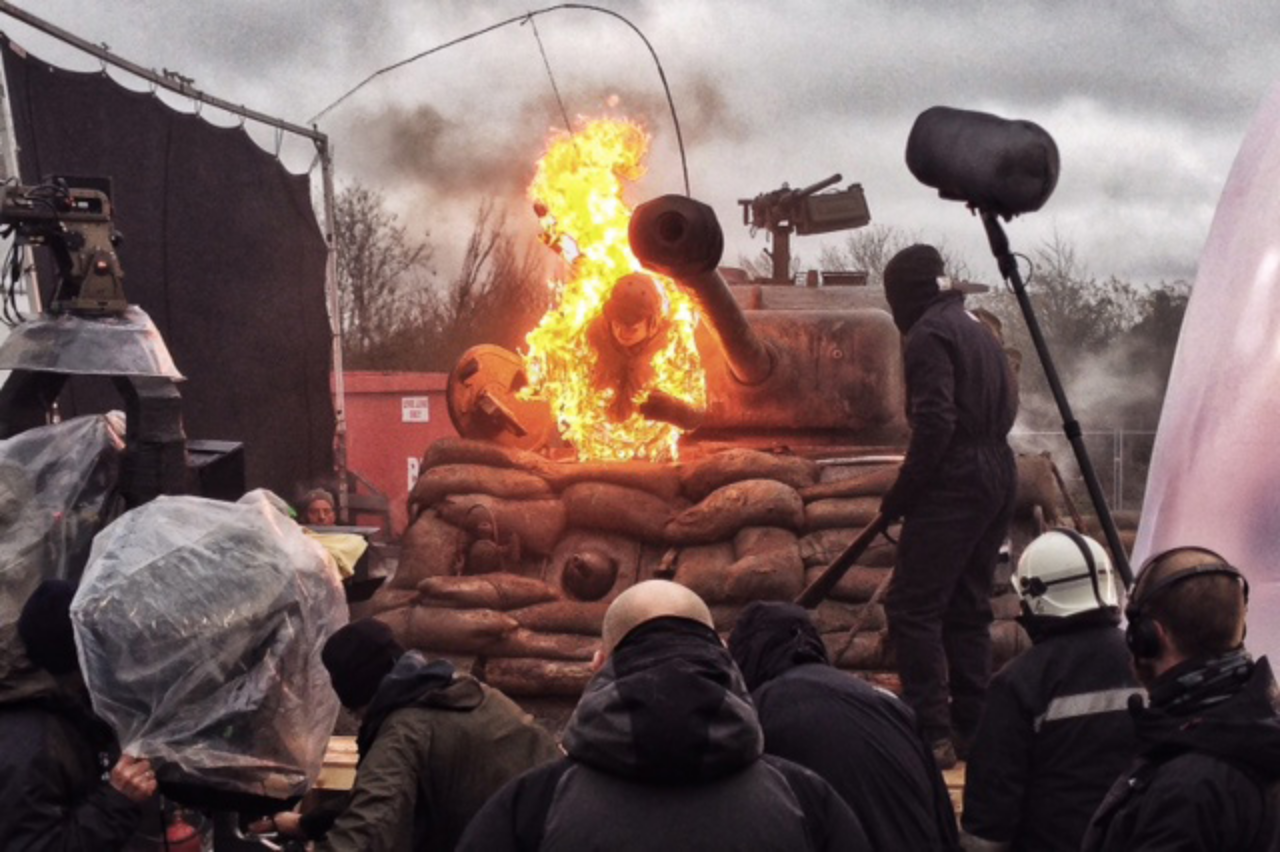
Talking Stunts with Kai Martin
by Isaaq Tomkins | July 23, 2023
So Kai, what have you been working on recently?
I’ve been working on the Amazon Prime TV show, The Lord of the Rings: Rings of Power. We’re on season two now. The first season was shot in New Zealand and then they came over to the UK and predominantly I’ve been playing an orc. So yeah, that’s taken up the bulk of my life recently. It’s been quite a few hours in prosthetics. Your call time is normally 04.00/04.15, and sometimes you don’t wrap until six or seven o’clock in the evening. So they’re big days.
And how did you start out as a stuntman?
I qualified as a stuntman in 2001. Back then you had to – and you still have to – do six disciplines, six areas of skill like a black belt in a martial art, a scuba diving dive-master, a trampoline test, a gymnastics test, also a fencing test.
So you had to choose your six disciplines from different categories like vehicles, horses, high falls, agility, strength. Then you submitted your application to the British Stunt Register.
You mention martial arts. In a previous interview you said that you trained in China for four months or so. Were you training with actual Shaolin monks?
Yeah.
That’s insane.
Yeah, it was pretty wild, quite frankly. It was in 2005, and I didn’t really even know if this Shaolin temple existed, but luckily a friend of a friend of a friend knew somebody that had trained there. So this Shaolin temple did exist in Northern China, in the province of Jilin. It was a bit like Kill Bill – there was this winding hill, and at the top of it there was a training academy. It was catered for Westerners in that they had translators, but still it was a pretty intense mental and physical experience. I would train for eight or nine hours a day. It was a very shaping experience for me in many ways because I grew in my skills and as a person. And then the next year I went onto Casino Royale, where my Bond journey started. I think all the skill levels, the fitness, the mental capacity that I had acquired definitely put me in good stead for that job.
When you were doing the Bond films, you’ve had to perform on cranes, cars, helicopters, suspended on ropes, underwater. Sometimes you were on location and other times rehearsing stunts for the lead actors in Pinewood Studios. Despite this obvious versatility, is there any sort of stunt that you most enjoy?
I suppose I used to – and I still do – like jumping around. I mean, I wouldn’t call myself a parkour person at all because that’s on the next level. Some of the things we’ve done in the movies, including the stuff I did in the Bourne Ultimatum looks a bit archaic now in comparison to what guys do out there today, but I used to really enjoy that element because there’s always a challenge in hitting your mark. So yeah, the physicality of stunts is the thing that I’ve most enjoyed.
Do you want to walk me through the process of how a stunt is devised and then performed?
Sure. So to start off, the stunt coordinator will be given the script. They will then break it down and they will find out where the action moments are. From there the stunt team receives previs. (previsualisation), in the form of a cartoon (previously they will have had storyboards). You build the stunt from there.
We ask ourselves how the action should be shot. Let’s say, for example, the stunt is a jerk back. We make sure that the area is completely matted-out. We start by trying different pick points on the jerk harness – it may take five or six attempts to find out where the sweet spot is in terms of where you’re gonna get pulled, and then what pressures you may have in what’s called an air ram. So then that will pull the stunt performer back. Then we often offer it up to the director. And based on what they think creatively, we either revisit the stunt or move on to another part of the script.
The reality is, it’s always an ongoing process. You can shoot, you can rehearse things for two, three months and then on the day of shooting it can all change again. And that can be very frustrating. But equally that is the process. That gives you your product. So I think it’s good to be adaptive, constantly open. At the same time, if you have rehearsed for a period of two, three months, then you’re sharp, and you’re ready to be adaptive.
Just how dangerous is the job?
You’re going to get hurt to a degree. It is what it is. Swimming instructors get wet, you know?
But it is a calculated risk being a stunt person and through the rehearsal process we can eliminate things, try to make them as tight and as safe as possible. But at the end of the day, if you’re being pulled twenty feet one way, and you’re landing on very thin matt, you take a hit.
But that’s why we train stunt people. I train daily, two, three times a day. The end is always to produce the greatest performance I can, and for that, I know I need to be strong, I need to be flexible. So if you do pull me fifteen, twenty feet, then I’ve prepared myself sufficiently to be able to do it multiple times.
What’s interesting is – and I’ve got to be careful what I say – there are actors out there that do their own action, and I respect them greatly – they’re dedicated, they’ve got the mindset. But a stuntman will rehearse that stunt 10, 15 times, with different pick points, different this, different that. And the rehearsals are where things really get worked out. And then what tends to happen is an action actor will come in at the very last minute to perform the stunt. Not to take anything away from them, but there is an element of spoon-feeding. A stunt person is different from an actor. You’re treated differently on set. It’s a different role.
A stunt person does get knocked about. That’s the nature of what it is. You shouldn’t come away injured really, but you can come away shaken, not stirred as they say. It’s part of the game
For the film Fury (2014), am I right in thinking that you were set on fire?
Yes.
Tell me a little about that
I suppose I’ve been set on fire my whole career. I did some fire burns recently on Lord of the Rings as well. The fire burn is quite common in a stunt person’s career. Psychologically it is a bit bizarre.
You either want to do it or you don’t. It’s as simple as that. But there are lots of safety precautions within that: the Nomex underwear, the Zel Jel, the fire suit or maybe a wetsuit that you wear as protection, the silicone mask, the silicone hands. Definitely the way the silicone masks have evolved over the years is phenomenal. When I look back to some of the fire burns which stunt guys used to do, it was pretty gnarly. I’m not sure if you remember the one in Saving Private Ryan – they’re in a bunker and then they crawl out. That was a gnarly stunt because those stunt guys had to be set on fire in that bunker and then brought out – I mean obviously I wasn’t there, and I’m sure there would’ve been fire safety within the bunker, but once you’ve got all your layers of Nomex on, you have to be as cool and as calm as possible, because you also have to hold your breath once the stunt has started. You sometimes get an inverted teat that goes into the fire mask, and just before you’re about to go up, the tube comes out. That’s gone. That would be your last breath. Your visibility can be impaired. So those guys in Saving Private Ryan would have been climbing out of a small space, they wouldn’t have seen where they’re going, and they would’ve been holding their breath trying to get out of there.
https://www.youtube.com/watch?v=kF3DvMiNVIY – Saving Private Ryan clip
So I think it’s about your mindset when it comes to a fire burn, because once you got the right gear on, then technically you are safe, but it’s how you handle yourself. If you panic, if you start to get all flustered, it could be a very, very horrible experience.
On Game of Thrones, I had to do a backwards fire burn. So I had to walk back like six or seven feet and then fall off a ledge. Bear in mind, I had no vision looking forward. I mean, if I asked you just to walk back and then hit your mark and do a mini, a five foot back fall anyways, some people may struggle with that. Anyway, I found my mark. I made sure there was like a little piece of tape with a ball on it which I could feel… And then I’d just close my eyes, practice my strides, practice my strides, practice my strides. It becomes second nature. Then the coordinator changed my first mark. That messed me up a little bit. But that’s how you prepare for something like that.
Is there any stunt that makes you nervous?
I mean, I’ve had an amazing career. I probably don’t have as many stunt years in front of me as I’ve had previously, but at the peak of my career, no, there wasn’t anything that I didn’t want to do. I think that was my strength. I was game for everything.
At the end of the day, it doesn’t matter how good your skill level is though – you have to turn skill into performance. You see some amazing gymnasts that have phenomenal physical skill –they’ll point their toes and land in a certain way – but stunts are ugly. It’s a performance,
Does anything stand out as an absolute career highlight for you?
I think it goes without saying, and I think for all the other guys that worked on it, it was Casino Royale. When we were making it, we were like, “Is this gonna be the shit bond?”. We had no concept of what we were creating. But the director, Martin Campbell, was amazing; the stunt coordinator, Gary Powell, was at the height of his powers; we were all very hungry and driven, ambitious, but we were also a team.
Some of the stuff we did was just so much fun: running across the crane and doing fights. And I suppose when you look back now, a lot of what we do as stunt people has been diluted to a point by health and safety and the aid of CGI. Why would a person now do 120 feet fall when we can go from 20 feet and then just merge you with visual effects? As a stunt person, you want to do that 120 feet fall, but unfortunately everything’s changed in society. So what we were doing at the time was pretty unique and fun and was great to really exercise your talent and push new boundaries.
And The Bourne Ultimatum as well. They were sandwich packed. So the momentum was already there in that period of time – same team, same coordinator, Gary – so those were definitely some of my peak years.
Considering the fact that your career is related to your physicality, how are things looking for you in the future? Do you think more about transitioning into things like stunt coordinating, acting et cetera?
When I was 23, I worked in Madrid and I used to play this character called ‘Miller’, and at the end of the show, Miller was such a crazy, comical character that he used to run and launch himself into a door and fall back and the whole audience would crack up, you know? And it hurt when I was 23, but I did it every time. Now I’m a little bit older, it’ll still hurt – it’s the same as when I was in 23, but I’ve done it already.
Once you’ve done it, that thirst has been quenched. That’s a great feeling. So there’s that, but also there’s the physicality of a stunt person. You can work into your fifties and sixties for sure, like Mike Massa who just doubled for Indie on the latest Indiana Jones film – he was amazing. What an incredible inspirational man. I think he was in his mid-fifties when he doubled for Harrison. I worked with him a couple of years ago and he was still smashing it out. But I think having done what I’ve done, I’ve scratched the itch.
I feel like my next challenge is acting. In the last twelve months I’ve been fortunate to have four cast parts, which has been great. I played Agent Fry in The Union,a Mark Wahlberg and Halle Berry film on Netflix that we shot in Italy last September, and then a couple of cast parts on Lord of the Rings have all been acting. And I start as another cast member on Star Wars on Friday. So that’s great. That’s the direction, the new challenge. A mountain I haven’t climbed yet. I get the same excited nervousness when I do it that I used to get in stunts. But you also have to be realistic. The film industry life is a pyramid of hierarchy, and acting is an even finer point of the pyramid than stunts. So you need a bit of luck, but you know what, I’m a lucky person.
Well, it is great to see that you’re always looking for a new challenge. I think we’ll wrap up there. Thank you so much for talking to me, Kai!
Interview by Isaaq Tomkins
Photos courtesy of http://www.kaimartin.co.uk/#photos




